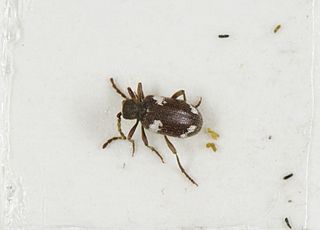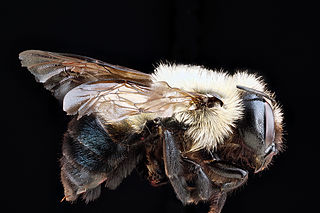
Pollination of fruit trees is required to produce seeds with surrounding fruit. It is the process of moving pollen from the anther to the stigma, either in the same flower or in another flower. Some tree species, including many fruit trees, do not produce fruit from self-pollination, so pollinizer trees are planted in orchards.

Megachilidae is a cosmopolitan family of mostly solitary bees. Characteristic traits of this family are the restriction of their pollen-carrying structure to the ventral surface of the abdomen, and their typically elongated labrum. Megachilid genera are most commonly known as mason bees and leafcutter bees, reflecting the materials from which they build their nest cells ; a few collect plant or animal hairs and fibers, and are called carder bees, while others use plant resins in nest construction and are correspondingly called resin bees. All species feed on nectar and pollen, but a few are kleptoparasites, feeding on pollen collected by other megachilid bees. Parasitic species do not possess scopae. The motion of Megachilidae in the reproductive structures of flowers is energetic and swimming-like; this agitation releases large amounts of pollen.

Mason bee is a name now commonly used for species of bees in the genus Osmia, of the family Megachilidae. Mason bees are named for their habit of using mud or other "masonry" products in constructing their nests, which are made in naturally occurring gaps such as between cracks in stones or other small dark cavities. When available, some species preferentially use hollow stems or holes in wood made by wood-boring insects.

Osmia lignaria, commonly known as the orchard mason bee or blue orchard bee, is a megachilid bee that makes nests in natural holes and reeds, creating individual cells for its brood that are separated by mud dividers. Unlike carpenter bees, it cannot drill holes in wood. O. lignaria is a common species used for early spring fruit bloom in the United States and Canada, though a number of other Osmia species are cultured for use in pollination.

Osmia bicornis is a species of mason bee, and is known as the red mason bee due to its covering of dense gingery hair. It is a solitary bee that nests in holes or stems and is polylectic, meaning it forages pollen from various different flowering plants. These bees can be seen aggregating together and nests in preexisting hollows, choosing not to excavate their own. These bees are not aggressive; they will only sting if handled very roughly and are safe to be closely observed by children. Females only mate once, usually with closely related males. Further, females can determine the sex ratio of their offspring based on their body size, where larger females will invest more in diploid females eggs than small bees. These bees also have trichromatic colour vision and are important pollinators in agriculture.

Ptinus sexpunctatus is a species of beetles in the genus Ptinus of the family Ptinidae. It is commonly known as the six-spotted spider beetle.
Osmia xanthomelana, the large mason bee, is a species of mason bee in the genus Osmia. It has a wide distribution in the Palearctic but it is rare wherever it occurs and, for example, in Great Britain it has a highly restricted distribution, although in the past it was a little more widespread there.

Osmia uncinata, the pinewood mason bee, is a species of solitary bee from the family Megachilidae It is an Arctic-alpine species which is found in the northern Palearctic, in the United Kingdom it is a Biodiversity Action Plan priority species.

Osmia bucephala, the bufflehead mason bee, is a species of bee in the family Megachilidae. It is found in North America.

Chaetodactylus krombeini,, was described by Karl Krombein and E. W. Baker in the 1960s. The mites are about 0.5 mm across, with the females larger than the males. Pollen mites are a kleptoparasitic pest of Megachilid solitary bees, with Ch. krombeini found with Osmia lignaria of North America,. Pollen mites do not feed on bees, but rather their provisions, and are harmful because they consume the food resources and starve or stunt the developing larvae; there is evidence that pollen mites also directly harm the egg by puncturing it.

Osmia calaminthae, commonly known as the blue calamintha bee, is a rare species of mason bee known only from two small areas in Florida, United States. It is considered Critically Imperiled by NatureServe. The common name for the bee is derived from its distinctly blue color and its favored host plant, Calamintha ashei.

Osmia aurulenta is a Palearctic species of mason bee.

Osmia nigriventris, also known as the large black-bellied mason bee, is a species of solitary bee within the family Megachilidae.
Osmia adae is a species of bees within the genus Osmia, also known as mason bees, in the Megachilidae family.
Osmia lanei is a species of bee belonging to the genus Osmia and the family Megachilidae. They are native to northern California. Like all mason bees, it is solitary and does not work in massive hives. The species was first described in 1939 by Grace A. Sandhouse.

Osmia albolateralis is a species of bee that lives across the US, mainly in the east, but also in the Canadian provinces of British Columbia, Alberta, and Quebec it belongs to the genus Osmia and the family Megachilidae. It was described by Cockerell in 1906.
Osmia aliciae is a species of bee in the family Megachilidae.
Osmia ariadne is a species of mason bee of the family Megachilidae. Female specimens were used to describe the species. Its hue is black, and females measure around 11 to 12 mm. It is distributed throughout Greece and Turkey.












